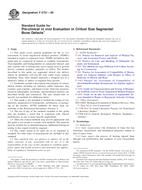Wir benötigen Ihre Einwilligung zur Verwendung der einzelnen Daten, damit Sie unter anderem Informationen zu Ihren Interessen einsehen können. Klicken Sie auf "OK", um Ihre Zustimmung zu erteilen.
ASTM F2721-09
Standard Guide for Pre-clinical in vivo Evaluation in Critical Size Segmental Bone Defects
Automatische name übersetzung:
Standard-Leitfaden für präklinische in vivo Evaluierung in kritische Größe Segmentknochendefekten
NORM herausgegeben am 1.6.2009
Informationen über die Norm:
Bezeichnung normen: ASTM F2721-09
Anmerkung: UNGÜLTIG
Ausgabedatum normen: 1.6.2009
SKU: NS-54430
Zahl der Seiten: 13
Gewicht ca.: 39 g (0.09 Pfund)
Land: Amerikanische technische Norm
Kategorie: Technische Normen ASTM
Die Annotation des Normtextes ASTM F2721-09 :
Keywords:
animal models, biomaterials, bone, bone regeneration, bone repair, defect generation, devices, implants, in vivo, mechanical testing, synthetic biomaterials, TEMPs (Tissue Engineered Medical Products), Animal experimentation, Biomaterials, Bone regeneration, Medical devices/equipment, Synthetic bone, Tissue engineered medical products (TEMPs), ICS Number Code 11.100.10 (In vitro diagnostic test systems)
Ergänzende Informationen
| Significance and Use | ||||||||||||
|
This guide is aimed at providing a range of in vivo models to aid in preclinical research and development of tissue-engineered medical products (TEMPs) intended for the clinical repair or regeneration of bone. This guide includes a description of the animal models, surgical considerations, and tissue processing as well as the qualitative and quantitative analysis of tissue specimens. The user is encouraged to use appropriate ASTM and other guidelines to conduct cytotoxicity and biocompatibility tests on materials, TEMPs, or both, prior to assessment of the in vivo models described herein. It is recommended that safety testing be in accordance with the provisions of the FDA Good Laboratory Practices Regulations 21 CFR 58. Safety and effectiveness studies to support regulatory submissions (for example, Investigational Device Exemption (IDE)), Premarket Approval (PMA), 510K, Investigational New Drug (IND), or Biologics License Application (BLA) submissions in the U.S.) should conform to appropriate guidelines of the regulatory bodies for development of medical devices, biologics, or drugs, respectively. Animal model outcomes are not necessarily predictive of human results and should, therefore, be interpreted cautiously with respect to potential applicability to human conditions. |
||||||||||||
| 1. Scope | ||||||||||||
|
1.1 This guide covers general guidelines for the in vivo assessment of tissue engineered medical products (TEMPs) intended to repair or regenerate bone. TEMPs included in this guide may be composed of natural or synthetic biomaterials (biocompatible and biodegradable) or composites thereof, and may contain cells or biologically active agents such as growth factors, synthetic peptides, plasmids, or cDNA. The models described in this guide are segmental critical size defects which, by definition, will not fill with viable tissue without treatment. Thus, these models represent a stringent test of a material’s ability to induce or augment bone growth. 1.2 Guidelines include a description and rationale of various animal models including rat (murine), rabbit (leporine), dog (canine), goat (caprine), and sheep (ovine). Outcome measures based on radiographic, histologic, and mechanical analyses are described briefly and referenced. The user should refer to specific test methods for additional detail. 1.3 This guide is not intended to include the testing of raw materials, preparation of biomaterials, sterilization, or packaging of the product. ASTM standards for these steps are available in the Referenced Documents (Section 2). 1.4 The use of any of the methods included in this guide may not produce a result that is consistent with clinical performance in one or more specific applications. 1.5 Other pre-clinical methods may also be appropriate and this guide is not meant to exclude such methods. The material must be suitable for its intended purpose. Additional biological testing in this regard would be required. 1.6 The values stated in SI units are to be regarded as standard. No other units of measurement are included in this standard. 1.7 This standard does not purport to address all of the safety concerns, if any, associated with its use. It is the responsibility of the user of this standard to establish appropriate safety and health practices and determine the applicability of regulatory limitations prior to use. |
||||||||||||
| 2. Referenced Documents | ||||||||||||
|
Empfehlungen:
Aktualisierung der technischen Normen
Wollen Sie sich sicher sein, dass Sie nur die gültigen technischen Normen verwenden?
Wir bieten Ihnen eine Lösung, die Ihnen eine Monatsübersicht über die Aktualität der von Ihnen angewandten Normen sicher stellt.
Brauchen Sie mehr Informationen? Sehen Sie sich diese Seite an.




 Cookies
Cookies
